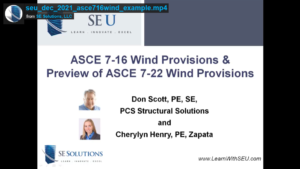New Effects of Changes to ASCE 7-16 Wind Provisions
ASCE 7 wind maps have changed! While the changes to the maps alone are significant, there have been other changes within the provisions which will largely affect most of the country. Depending on your region of practice, the updates may have significant implications for new building construction. Are you aware of the most significant changes between ASCE 7-10 and ASCE 7-16?
In the December 2021 SEU session, Don Scott, PE, SE, from PCS Structural Solutions, and Cherylyn Henry, PE, from Zapata, presented ASCE 7-16 Wind Provisions (plus Updates). Don and Cherylyn explained the significant changes to the wind maps and provisions in ASCE 7-16 including the differences between ASCE 7-10 and 7-16 low-rise components and cladding roof pressures. They also covered the wind chapter changes between ASCE 7-16 and 7-22 including the tornado provisions.
Don gave an excellent visual demonstration of how significant the changes to the low-rose component and cladding roof pressures were between ASCE 7-10 and 7-16. Click below to watch a short 3 minute video to see some examples of how the roof zone areas and pressures have changed:
The above examples show the new effects of the ASCE 7-16 wind map changes including the decrease of wind speeds along the west coast, the unchanged wind speeds through the great plains and hurricane prone regions, as well as how the elevation factor can affect the wind pressures. Most significantly, the changes to the roof pressure coefficients are apparent due to the results of new testing and more data. Most of the country will experience some change to the component and cladding wind pressure updates in ASCE 7-16, as a result, so it’s important to be aware of the changes in the code.



There are no comments yet, but you can be the first